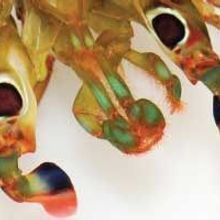Login
Subscribeanatomy, neuroscience

Smell May Be Possible Without Olfactory Bulbs
Jef Akst | Nov 6, 2019 | 2 min read
A study identifies five women who have a functioning sense of smell despite an apparent lack of olfactory bulbs—the region of the brain that processes odors.

Image of the Day: Smell Circuits
Nicoletta Lanese | Jul 24, 2019 | 1 min read
The brain wiring behind scent processing seems to scale across mammalian species.

Biologists Create New Maps of Caenorhabditis elegans Neurons
Chia-Yi Hou | Jul 8, 2019 | 2 min read
The connectomes trace 385 neurons in the male worm and 302 neurons in the hermaphrodite worm.

Why Human Speech Is Special
Philip Lieberman | Jul 1, 2018 | 10+ min read
Evolutionary changes in both the vocal tract and the brain were necessary for humans’ remarkable gift of gab.

Primer: Acoustics and Physiology of Human Speech
Philip Lieberman | Jun 30, 2018 | 2 min read
People have a unique anatomy that supports our ability to produce complex language.

Insects’ Neural Learning and Memory Center Discovered in Crustaceans
Catherine Offord | Dec 1, 2017 | 4 min read
Aggressive little marine predators, mantis shrimps possess a mushroom body that appears identical to the one found in insects.

Neural Network Found That Helps Control Breathing
Catherine Offord | Nov 1, 2016 | 2 min read
The results suggest that breathing is orchestrated by three—rather than two—excitatory circuits in the medulla.

Another Neural Circuit that Controls Breathing Found
Catherine Offord | Oct 31, 2016 | 1 min read
This third excitatory network helps to regulate postinspiration.

Orchid Bees Use Simple Eyes to Detect Polarized Light
Catherine Offord | Sep 1, 2016 | 3 min read
The second visual field may aid in navigation.

Fruit Flies Feel Humidity with Dedicated Receptors
Alison F. Takemura | Sep 1, 2016 | 2 min read
Drosophila antennae let the insects seek out moisture levels they like best.

Cortical Census
Ruth Williams | Nov 26, 2015 | 3 min read
Scientists document the characteristics and connections of mouse neocortical neurons to establish the most detailed microcircuit map to date.

Dr. Hearing
The Scientist | Aug 31, 2015 | 1 min read
James Hudspeth talks brain processing and hearing in this video from Rockefeller University.

The Neuron Doctrine, circa 1894
Chris Palmer | Nov 1, 2013 | 3 min read
Santiago Ramón y Cajal used a staining technique developed by Camillo Golgi to formulate the idea that the neuron is the basic unit of the nervous system.

Speed-Sensitive Denticles
Kerry Grens | Apr 1, 2013 | 4 min read
Tooth-like structures on the skin of a South American fish might serve as high-velocity water-flow detectors.
Interview: Speaking of Memory
Edyta Zielinska | Oct 1, 2011 | 4 min read
Considered a renegade by his peers, Nobel Prize-winner Eric Kandel used a simple model to probe the neural circuitry of memory.
